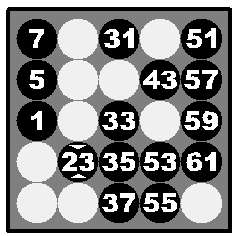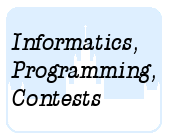Подразделы
Другие разделы
| Тренировка 1 |
| Тренировка 2 |
| Тренировка 4 |
| Тренировка 5 |
Дата и время
30/12/2025 08:32:09
 Тренировка 3
Тренировка 3
A. Average distance B. Bus Pass C. Cutting Banknotes D. Dice Password Security E. Lingo F. Splitting the Loot G. Pachinko H. Hiking I. Ranking J. Stock
 E. Lingo
E. Lingo
 Олимпиадные задачи на английском языке
Олимпиадные задачи на английском языке
| 04/02/2008 | Зима 2008 дорешивание (3E) |
| 07/02/2008 | Тренировка (задачи Benelux APC 2007) (E) |
Ограничения: время – 10s/20s, память – 64MiB Ввод: input.txt или стандартный ввод Вывод: output.txt или стандартный вывод 
Послать решение Blockly Посылки Темы Где Обсудить (0)
You are going to participate in the television show 'lingo'. You are very confident that you
will make the finals of the show. This is not only because you are well prepared, but also
because you managed to find a way to use your pda unnoticed during the contest, and you
have already written a program to help you with the bonuswords.
In the finals of the show, you first solve as many lingo words as possible within the allowed
time. This determines how many balls you may take afterwards. The more balls you may
take, the higher your probability is of winning the finals. But it is not easy to see what
this probability is. Write a program to help you with this.

Figure 1: Grid of first sample case
For those who don't know the game of lingo, here follows a description of the last part of
the finals, where you take the balls. You are given a square grid. Some squares in this
grid are covered and the other squares contain numbers. A hopper in front of you contains
numbered balls; there is exactly one ball for each numbered grid square. You take a ball
at random (without replacement) from this hopper for each lingo word you solved in the
first part of the finals. When you take a ball, the corresponding square in the grid becomes
covered. You win the finals if an entire row, column or diagonal consist of only covered
squares.
Input
On the first line an integer `t` `(1\ ≤\ t\ ≤\ 100)`: the number of test cases. Then for each test
case:
One line with the integers `n` `(1\ ≤\ n\ ≤\ 8)` and `k` `(0\ ≤\ k)`, where `n` is the size of the
lingo grid and `k` is the number of words you solved in the first part of the finals.
`n` lines, with on each line exactly `n` characters. Each character will be either '*' or
'.', representing a covered square and a numbered square respectively.
There will be at least `k` numbered squares on the board, and there is no row, column or
diagonal covered yet.
Output
For each testcase:
One line with the percentage of getting lingo with an absolute error of at most `10^{-6}`.
Sample Input
1 5 7 .*.*. .**.. .*.*. *.... **..*
Sample Output
82.703962

 Начало
Начало